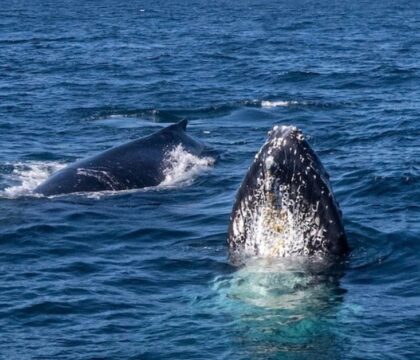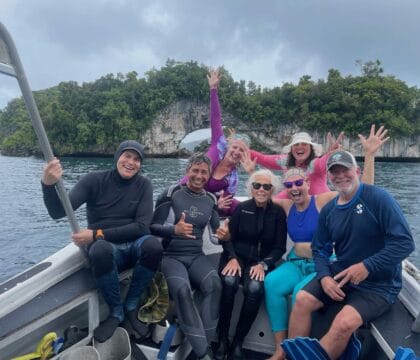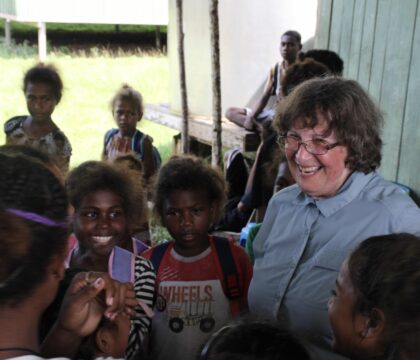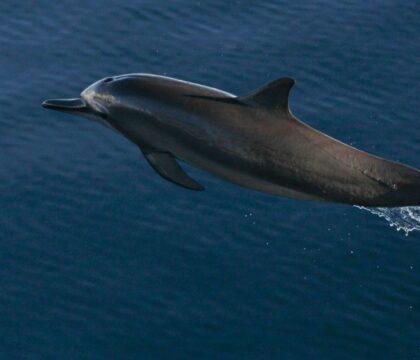May 24, 2016 • Trip Reports
I was fortunate to co-lead Oceanic Society’s Raja Ampat: Coral Triangle Adventure expedition in February 2016, during which we spent more than a week exploring beautiful Raja Ampat, Indonesia aboard the 124-foot Pindito. We encountered far too much to describe in detail here, but I wanted to share the following snippets from our trip log.
An aerial view of Raja Ampat. © Eric Ramos
Day 1: The seas of Indonesia welcomed us with flat waters and slightly overcast skies of breaking clouds. I traveled with our group of excited guests by small plane from the bustling city of Jakarta to Sorong, where we would find the Pindito, our home for the next 12 days on this expedition to the islands of Raja Ampat. The ever-helpful crew of the Pindito met us at the airport to usher us to the large ship with a crew of more than 15 people. We settled into our cabins as the last of the crew arrived and by late afternoon we set sail in search of whales and dolphins from above and the rest of marine life below the waves, snorkeling in some of the most biodiverse waters of the world amid the Coral Triangle. Dalton Ambat, who has guided a number of trips for Oceanic Society, and Benjamin Kahn, a marine mammal expert in the region, joined us to improve the experience for our guests and to maximize our appreciation for all that the region has to offer. Importantly, Ben would also use the trip as a platform to collect valuable marine mammal observation data to contribute to his successful endeavors to gain protections for these animals and their habitats.
Day 2: Pulau Mioskon, Pulau Wai, Pulau Dua. In the morning, the crew brought us to the Mioskon Slope on the north side of the Dampier Strait, where sea creatures flurried about on a vast stretch of coral reef that extends from the shore of the islands. We arrived to a shallow habitat near a small island full of a complex array of coral reef habitats and fish diversity to match. A great anemone of dark blue and purple emerged from its coral surroundings to make a lovely home for a pair of clownfish.
A clownfish takes shelter within an anemone. © Eric Ramos
After a refreshing break aboard the ship, we departed mid-morning to a flat bay where the crew surprised us with a snorkel with enormous manta rays swimming in graceful curves 20 feet below. Their immense dark forms glided forward with minute flaps of their wings that traced gentle contours in the waters about them as they spiraled upside-down and back towards the seabed, their cavernous mouths agape. With every held breath and dive towards their world, the waters would clear and the vivid contrast of their sharp black with the sandy bottom and mountainous boulders of hard coral would come into focus. Upon our return, one of the zodiacs was even approached by a mother-calf dolphin pair.
A manta ray swims by, with remoras in tow. © Eric Ramos
After a full day of snorkeling, we began our second objective for the trip: to search for the large marine mammals that this location is known for. Our search did not disappoint, as we encountered two Bryde’s whales, a mother-juvenile pair, traveling at the surface and periodically diving for minutes to forage on some prey unknown to us. Images of their fins provide Benjamin with some identification matches for his small catalog of the “Papua” whales, a group that may specifically inhabit this region.
Day 3: Our thirst for exploration extended into the land and sky as we rose early in the day to explore the avian life of the islands at our anchorage. Cruising on the three small zodiacs in the dawn light, whistles and chirps erupted from the lush green trees and vegetation blanketing the islands. Cockatoos made raucous sounds at the treetops. Sharp shrieks emerged from the bush. We scanned across each branch and observed tens of species I had only ever seen in zoos or as pets.
Exploring the coastline by zodiac. © Eric Ramos
With our appetite for the water whet from the previous afternoon, we entered the sea early from then on and our groups divided and conquered each pristine and biologically booming place we visited. Our group divided naturally into various teams in search of different forms of marine life. “Team Nudibranch” searched the crevices and walls of coral for the minuscule and varied color forms of the nudibranch, small marine gastropod molluscs that have evolved a host of beautiful color patterns and designs that bedazzle the eye and scare off wary predators, fearful of a potentially toxic treat.
One of many colorful nudibranchs we encountered (Goniobranchus leopardus). © Eric Ramos
A “blue dragon” nudibranch (Pteraeolidia ianthina). © Eric Ramos
Days 5-7: While on the boat, we took in the scenery of blissfully calm waters. Once headed off for a snorkel foray, our group of enthusiastic guests were more like a gang of aquatic mammals. Each site offered a new perspective into the life that springs forth from the reef, and we savored each day. In one location, sharply sloping island walls were covered in a variety of sea slugs and anemones that blanketed every piece of coral and bare stone—a tapestry of wriggling tube-shaped critters, life in full bloom. At another snorkel site, a large swath of coral reef provided us close-ups to the microcosms of marine fauna, while simultaneously off to our left, large fish and creatures inhabiting the open sea swam by, including a massive school of bumphead parrotfish. They would rise up from some unknown depth, bucktoothed yet severe-looking in a steady, schooling swim.
A colorful section of coral reef. © Eric Ramos
Day 9: In a democratic fashion, each night the crew would confer with us after dinner as to the plans for the coming days. They informed us of the possibility of visiting caves that the owner and proprietor of the ship, Edi, had found many years ago in his early explorations, when much of this region remained largely untouched by the modern world. We unanimously cast our votes to explore these caves, and two days later we awoke early to prepare for our day’s adventure. Traveling by small zodiac, we hugged the coast until we could enter a river opening between islands of lush green forest. In one cave, we observed human remains placed on the ground at some distant time. The next cave had an archway entrance that rose high above the water. We awaited the tide before attempting to enter its dark and mysterious innards. Once ready, each boat entered with a flashlight beaming a bright light into our dark path. Darkness all but enveloped us forty feet past the entrance. Above, a bright light shone through a natural opening in the cave roof. Its rays touched a glistening rock formation and illuminated a sinuous path into the sky. We dipped into fresh waters and watched raindrops fall from cave ceilings in a musical fashion.
Vegetation lines the narrow passage between two islands. © Eric Ramos
Day 11: On our final day, the dolphins emerged in true form. A group of small dolphins leaped over calm waters in bewildering, exuberant movements. In the distance soon after, sharp black shapes broke the mirror surface of the Ceram Sea. Ben speculated it may be a species of blackfish whale. When we approached closely enough, we saw a group of 60+ short finned pilot whales (Globicephala macrorhynchus). Their elongated onyx forms were clustered tightly, and through their size we could distinguish the large adult males and mothers and their small calves.
Another brightly colored nudibranch (Chromodoris annae). © Eric Ramos
The seas of Indonesia left an indelible mark on our group—a reminder of the wonder of nature in regions distant from our home. The biodiversity and health of marine ecosystems in Indonesia are etched in memory as one of the most marvelous perspectives of the diversity of life. After more than a week sailing the some of the most biodiverse waters of the world, we ended our trip with Captain’s dinner. Food spread out far and wide across makeshift tables on the deck. Our meal was generously followed by a performance of the Pindito band, singing traditional and popular songs in Bahasa. Later, we danced till the stars came out as a final farewell to this special place.
Click here to learn more about our Raja Ampat: Coral Triangle Adventure expedition or to sign up to participate in 2017.




